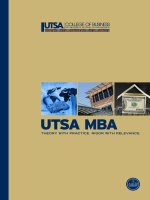Entrepreneurship theory process practice 8e by kuratko 8e ch 11
Bạn đang xem bản rút gọn của tài liệu. Xem và tải ngay bản đầy đủ của tài liệu tại đây (1.45 MB, 37 trang )
Part III
Developing the
Entrepreneurial Plan
CHAPTER
11
Financial
Preparation for
Entrepreneurial
Ventures
© 2009 South-Western, a part of Cengage Learning.
All rights reserved.
PowerPoint
PowerPoint Presentation
Presentation by
by Charlie
Charlie Cook
Cook
The
The University
University of
of West
West Alabama
Alabama
Chapter Objectives
1.
To explain the principal financial statements
needed for any entrepreneurial venture: the
balance sheet, income statement, and cashflow statement
2.
To outline the process of preparing an
operating budget
3.
To discuss the nature of cash flow and to
explain how to draw up such a document
4.
To describe how pro forma statements are
prepared
5.
To explain how capital budgeting can be used
in the decision-making process
© 2009 South-Western, a part of
Cengage Learning. All rights reserved.
11–2
Chapter Objectives
6.
To illustrate how to use break-even analysis
7.
To describe ratio analysis and illustrate the
use of some of the important measures and
their meanings
© 2009 South-Western, a part of
Cengage Learning. All rights reserved.
11–3
The Importance of Financial Information
for Entrepreneurs
• Significant Information for Financial
Management
The importance of ratio analysis in planning
Techniques and uses of projected financial statements
Techniques and approaches for designing a cash-flow
schedule
Techniques and approaches for evaluating the capital
budget
© 2009 South-Western, a part of
Cengage Learning. All rights reserved.
11–4
Understanding the Key Financial
Statements
• Balance Sheet
Represents the financial condition of a company at a
certain date.
• It details the items the company owns (assets) and the
amount the company owes (liabilities).
• It also shows the net worth of the company and its liquidity.
Assets = Liabilities + Owners’ Equity
• An asset is something of value the business owns.
– Current and fixed assets
• Liabilities are the claims creditors have against the company.
– Short- and long-term debt
• Owners’ equity is the residual interest of the firm’s owners in
the company.
© 2009 South-Western,
a part of
Cengage Learning. All rights reserved.
11–5
Table
11.2
Kendon Corporation Balance Sheet for the Year Ended
December 31, 2010
© 2009 South-Western, a part of
Cengage Learning. All rights reserved.
11–6
Understanding the Key Financial
Statements (cont’d)
• Income Statement
Commonly referred to as the P&L (profit and loss)
statement from activities of the firm.
Provides the results of the firm’s operations.
• Income Statement Categories
Revenues: gross sales for the period
Expenses: Costs of producing goods or services
Net Income: The excess (deficit) of revenues over
expenses (profit or loss)
© 2009 South-Western, a part of
Cengage Learning. All rights reserved.
11–7
Table
11.3
Kendon Corporation Income Statement for the Year Ended
December 31, 2010
© 2009 South-Western, a part of
Cengage Learning. All rights reserved.
11–8
Understanding the Key Financial
Statements (cont’d)
• Statement of Cash Flow
An analysis of the cash availability and cash needs of
the business that shows the effects of a company’s
operating, investing, and financing activities on its
cash balance.
•
•
•
•
How much cash did the firm generate from operations?
How did the firm finance fixed capital expenditures?
How much new debt did the firm add?
Was cash from operations sufficient to finance fixed asset
purchases?
The use of a cash budget may be the best approach
for an entrepreneur starting up a venture.
© 2009 South-Western, a part of
Cengage Learning. All rights reserved.
11–9
Table
11.4
Format of Statement of Cash Flows
© 2009 South-Western, a part of
Cengage Learning. All rights reserved.
11–10
Preparing Financial Budgets
• Budget
One of the most powerful tools the entrepreneur can
use in planning financial operations.
• Operating Budget
A statement of estimated income and expenses over a
specified period of time.
• Cash Budget
A statement of estimated cash receipts and
expenditures over a specified period of time.
• Capital Budget
The plan for expenditures on assets with returns
expected to last beyond one year.
© 2009 South-Western, a part of
Cengage Learning. All rights reserved.
11–11
The Operating Budget
• Sales Forecasting
Creating an operating budget through preparation of
the sales forecast.
• Forecasting
Linear regression: a statistical forecasting technique.
Y = a + bx
• Y is a dependent variable—its value is dependent on the
values of a, b, and x.
• x is an independent variable that is not dependent on any of
the other variables
• a is a constant.
• b is the slope of the line of correlation (the change in Y
divided by the change in x).
© 2009 South-Western, a part of
Cengage Learning. All rights reserved.
11–12
Figure
11.1
Regression Analysis
© 2009 South-Western, a part of
Cengage Learning. All rights reserved.
11–13
Table
11.5
North Central Scientific: Sales Forecast for 2010
© 2009 South-Western, a part of
Cengage Learning. All rights reserved.
11–14
Table
North Central Scientific: Purchase Requirements
Budget for 2010
11.6
© 2009 South-Western, a part of
Cengage Learning. All rights reserved.
11–15
Table
Dynamic Manufacturing: Production Budget
Worksheet for 2010
11.7
© 2009 South-Western, a part of
Cengage Learning. All rights reserved.
11–16
The Cash-Flow Budget
• Cash-Flow Budget
Provides an overview of the cash inflows and outflows
during the period. By pinpointing cash problems in
advance, management can make the necessary
financing arrangements.
• Preparation of the cash-flow budget
Identification and timing of three cash inflows:
•
•
•
Cash sales
Cash payments received on account
Loan proceeds
Minimum cash balance
© 2009 South-Western, a part of
Cengage Learning. All rights reserved.
11–17
Table
11.8
North Central Scientific: Expense and Operating
Budgets
In order to identify the behavior of the different expense accounts, John Wheatman
decided to analyze the past five years’ income statements. Following are the results of
his analysis:
• Rent is a constant expense and is expected to remain the same during the next
year.
• Payroll expense changes in proportion to sales, because the more sales the store
has, the more people it must hire to meet increased consumer demands.
• Utilities are expected to remain relatively constant during the budget period.
• Taxes are based primarily on sales and payroll and are therefore considered a
variable expense.
• Supplies will vary in proportion to sales. This is because most of the supplies will be
used to support sales.
• Repairs are relatively stable and are a fixed expense. John has maintenance
contracts on the equipment in the store, and the cost is not scheduled to rise during
the budget period.
© 2009 South-Western, a part of
Cengage Learning. All rights reserved.
11–18
Table
North Central Scientific: Expense and Operating
Budgets (cont’d)
11.8
© 2009 South-Western, a part of
Cengage Learning. All rights reserved.
11–19
Table
11.9
North Central Scientific: Cash-Flow Budget
© 2009 South-Western, a part of
Cengage Learning. All rights reserved.
11–20
Pro Forma Statements
• Pro Forma Statements
Are projections of a firm’s financial position over a
future period (pro forma income statement) or on a
future date (pro forma balance sheet).
Using beginning balance sheet balances, they depict
projected changes on the operating and cash-flow
budgets which are added to create projected balance
sheet totals.
© 2009 South-Western, a part of
Cengage Learning. All rights reserved.
11–21
Table
11.10
North Central Scientific: Pro Forma Statements
© 2009 South-Western, a part of
Cengage Learning. All rights reserved.
11–22
Table
11.10
North Central Scientific: Pro Forma Statements
(cont’d)
© 2009 South-Western, a part of
Cengage Learning. All rights reserved.
11–23
Capital Budgeting
• The Capital Budgeting Process
Identification of cash inflows or returns and their timing
• The inflows are equal to net operating income before
deduction of payments to financing sources but after
deduction of applicable taxes and with depreciation added
back, as represented by the following formula:
Expected Returns = X(1 – T) + Depreciation
– X is equal to the net operating income
– T is defined as the appropriate tax rate
• Capital Budgeting Objectives
Which of several mutually exclusive projects should
be selected?
How many projects, in total, should be selected?
© 2009 South-Western, a part of
Cengage Learning. All rights reserved.
11–24
Table
North Central Scientific: Expected Return
Worksheet
11.11
© 2009 South-Western, a part of
Cengage Learning. All rights reserved.
11–25









